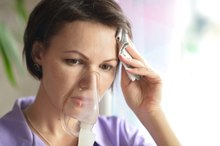Breathing Treatments for Pneumonia
Pneumonia is a serious illness that occurs due to an infection in the lungs 1. It can cause a fever, chills, muscle aches, fatigue, a cough and trouble breathing. In some cases this condition clears up in a few weeks with home treatment. However in children, the elderly and those with compromised immune systems, it can become life-threatening. The first step in treatment, is to seek medical attention and follow a doctor's orders in regards to medication. In addition, try breathing treatments for pneumonia, if breathing problems become severe 1.
If you are experiencing serious medical symptoms, seek emergency treatment immediately.
Diaphragmatic Breathing
The risk for developing pneumonia is higher in individuals due to respiratory infections, diseases, surgery or injuries tend to breathe very shallow, claims Merck 1. If the ability to cough is restricted, the risk rises as well. When breathing and/or coughing is compromised, the lungs are not able to fully clear themselves, which can set the stage for bacteria, viruses and other substances to multiply.
Along with rest, drinking plenty of fluids and taking any medication prescribed, it may be helpful to practice a deep breathing exercise. This involves taking slow deep breaths in and out through the nose. If exhaling through the nose is difficult, a patient can exhale through pursed lips. Deep breathing will help to clear the lungs and increase oxygen levels in the blood.
- The risk for developing pneumonia is higher in individuals due to respiratory infections, diseases, surgery or injuries tend to breathe very shallow, claims Merck 1.
- When breathing and/or coughing is compromised, the lungs are not able to fully clear themselves, which can set the stage for bacteria, viruses and other substances to multiply.
Rhythmic Breathing And Coughing
Bronchitis Symptoms With Allergies
Learn More
To help effectively clear the lungs, a patient recovering from pneumonia may need to practice how to cough effectively 1. The University of Maryland Medical Center, suggests talking with a respiratory therapist to learn the correct process.
This technique involves lightly tapping the chest and back to loosen and mucus. Then take three to four rhythmic breaths. This is followed by producing a deep cough to help clear the lungs. It is important to learn this technique from a trained professional, as forceful coughing the wrong way can do more harm than good.
- To help effectively clear the lungs, a patient recovering from pneumonia may need to practice how to cough effectively 1.
- It is important to learn this technique from a trained professional, as forceful coughing the wrong way can do more harm than good.
Incentive Spirometer
An incentive spirometer is a hand held device that can teach a patient to breathe more deeply, to help keep the lungs clear. Using a spirometer involves taking slow deep breaths through a mouth piece, which causes a ball or piston to rise. The goal is to raise the ball or piston as high as possible with each breath. A doctor or therapist can advise on a goal to reach for. After inhaling as deeply as possible remove the mouth piece, hold the breath in a few seconds, exhale slowly and then return to normal breathing.
The Ohio State University Medical Center, recommends repeating this process about 10 times in a row and then coughing to clear the lungs. A health care professional can provide instructions as to how often this should be done throughout the day.
- An incentive spirometer is a hand held device that can teach a patient to breathe more deeply, to help keep the lungs clear.
- The Ohio State University Medical Center, recommends repeating this process about 10 times in a row and then coughing to clear the lungs.
Supplemental Oxygen
Breathing Exercises After Pneumonia
Learn More
If breathing difficulties become severe, it may be necessary to use supplemental oxygen therapy, states the American Lung Association 2. This can be provided while in the hospital and units can be used at home. Oxygen can also come in small canisters that can be carried around, to allow the patient to remain active.
A physician and respiratory therapist will determined the type of therapy. Some patients use supplemental oxygen therapy on an as needed basis, while others need it continuously.
- If breathing difficulties become severe, it may be necessary to use supplemental oxygen therapy, states the American Lung Association 2.
- Some patients use supplemental oxygen therapy on an as needed basis, while others need it continuously.
Related Articles
References
- Merck: Pneumonia
- American Lung Association: Supplemental Oxygen
- Almirall J, Serra-prat M, Bolíbar I, Balasso V. Risk factors for community-acquired pneumonia in adults: a systematic review of observational studies. Respiration. 2017;94(3):299-311. doi:10.1159/000479089
- Komiya K, Ishii H, Kadota J. Healthcare-associated Pneumonia and Aspiration Pneumonia. Aging Dis. 2014;6(1):27–37. doi:10.14336/AD.2014.0127
- Frantzeskaki F, Orfanos SE. Treating nosocomial pneumonia: what's new. ERJ Open Res. 2018;4(2):00058-2018. doi:10.1183/23120541.00058-2018
- American Lung Association. Pneumonia symptoms and diagnosis. Updated May 27, 2020.
- Morris DE, Cleary DW, Clarke SC. Secondary bacterial infections associated with influenza pandemics. Front Microbiol. 2017;8:1041. doi:10.3389/fmicb.2017.01041
- Chughtai M, Gwam CU, Mohamed N, et al. The epidemiology and risk factors for postoperative pneumonia. J Clin Med Res. 2017;9(6):466–475. doi:10.14740/jocmr3002w
- Garin N, Marti C, Scheffler M, Stirnemann J, Prendki V. Computed tomography scan contribution to the diagnosis of community-acquired pneumonia. Curr Opin Pulm Med. 2019;25(3):242–248. doi:10.1097/MCP.0000000000000567
- Mantero M, Tarsia P, Gramegna A, Henchi S, Vanoni N, Di Pasquale M. Antibiotic therapy, supportive treatment and management of immunomodulation-inflammation response in community acquired pneumonia: review of recommendations. Multidiscip Respir Med. 2017;12:26. doi:10.1186/s40248-017-0106-3
- Principi N, Esposito S. Prevention of community-acquired pneumonia with available Pneumococcal vaccines. Int J Mol Sci. 2016;18(1):30. doi:10.3390/ijms18010030
- Mayo Clinic Staff. Pneumonia. Mayo Clinic. Updated March 13, 2018.
- National Heart, Lung, and Blood Institute. Pneumonia. National Institutes of Health. U.S. Department of Health & Human Services.
Writer Bio
I hold a Master's degree in exercise physiology/health promotion. I am a certified fitness specialist through the American College of Spots Medicine and an IYT certified yoga teacher. I have over 25 years experience teaching classes to both general public and those with chronic illness. The above allows me to write directly to the reader based on personal experiences.







